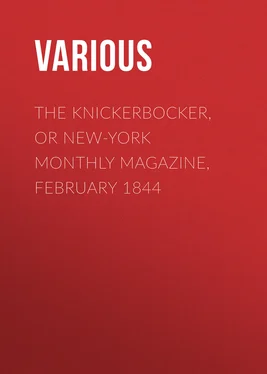Various - The Knickerbocker, or New-York Monthly Magazine, February 1844
Здесь есть возможность читать онлайн «Various - The Knickerbocker, or New-York Monthly Magazine, February 1844» — ознакомительный отрывок электронной книги совершенно бесплатно, а после прочтения отрывка купить полную версию. В некоторых случаях можно слушать аудио, скачать через торрент в формате fb2 и присутствует краткое содержание. Жанр: foreign_antique, periodic, foreign_edu, на английском языке. Описание произведения, (предисловие) а так же отзывы посетителей доступны на портале библиотеки ЛибКат.
- Название:The Knickerbocker, or New-York Monthly Magazine, February 1844
- Автор:
- Жанр:
- Год:неизвестен
- ISBN:нет данных
- Рейтинг книги:3 / 5. Голосов: 1
-
Избранное:Добавить в избранное
- Отзывы:
-
Ваша оценка:
- 60
- 1
- 2
- 3
- 4
- 5
The Knickerbocker, or New-York Monthly Magazine, February 1844: краткое содержание, описание и аннотация
Предлагаем к чтению аннотацию, описание, краткое содержание или предисловие (зависит от того, что написал сам автор книги «The Knickerbocker, or New-York Monthly Magazine, February 1844»). Если вы не нашли необходимую информацию о книге — напишите в комментариях, мы постараемся отыскать её.
The Knickerbocker, or New-York Monthly Magazine, February 1844 — читать онлайн ознакомительный отрывок
Ниже представлен текст книги, разбитый по страницам. Система сохранения места последней прочитанной страницы, позволяет с удобством читать онлайн бесплатно книгу «The Knickerbocker, or New-York Monthly Magazine, February 1844», без необходимости каждый раз заново искать на чём Вы остановились. Поставьте закладку, и сможете в любой момент перейти на страницу, на которой закончили чтение.
Интервал:
Закладка:
Our purpose was to see the sun rise from the summit of Ætna; and at nine in the evening, our mules and guides being ready, we put on our Sicilian capotes, and sallied forth. We had two guides, a muleteer, and as there was no moon, a man with a lantern to light the mules in their passage over the beds of lava. For several miles the way was uninteresting, it being too dark to see any thing except the horrid lava or sand beneath the feet of the mules. At times the road was so steep that we were ordered by our guides to lean forward on the necks of the mules, to keep them and ourselves from being thrown back. At length we entered the woody region. Here the path was less rocky; and as we wound up the mountain’s side, beneath the shadows of noble trees, I could not but feel the solemn quietness of a night on Ætna, and contrast it with what has been and what will in all probability be again, the intermitting roar of the neighboring volcano, and the dreadful thunder of the earthquake. At midnight we arrived at the Casa delle Neve , or House of Snow. This is a rude building of lava, with bare walls, entirely destitute of furniture. We made a fire on the ground, took some refreshments which we had brought with us, and in about an hour remounted our mules, and proceeded on our journey. We soon left the region of woods; and being now at an elevation of seven thousand feet above the sea, felt somewhat cold, and buttoned our capotes closer about us. From the ridges of lava along which we rode, by the light of the stars which now became brilliant, we could discern the snow stretching in long lines down the ravines on either hand; and as we advanced, approaching nearer and nearer, until at length it spread in broad fields before us. As the mules could go no farther, we dismounted, and taking an iron-pointed staff in our hands, we commenced the journey over the snows. It was now half-past one, and we had seven miles to traverse before reaching the summit. The first part of the ascent was discouraging, for it was steep, and the snow so slippery that we sometimes fell on our faces; but it became rather less steep as we ascended, and though fatiguing, we got along comfortably. As the atmosphere was becoming rare, and the breathing hurried, we sat on the snow for a few minutes now and then. At such times we could not but be struck with the splendor of the stars, far beyond any thing I had ever seen. The milky way seemed suspended in the deep heavens, like a luminous cloud, with clear and definite outline. We next arrived at the Casa degli Inglese ; so called, but alas for us! the ridge of the roof and a part of the gable were all that rose above the snow. In the midst of summer, travellers may make use of it; but to us it was unavailing, except the gable, which served in a measure to shield us from the icy wind which now swept over the mountain. We again partook of a little refreshment, by way of preparation for the most arduous part of our undertaking, and were now at the foot of the great cone. The ascent was toilsome in the extreme. Snow, melted beneath in many places by the heat of the mountain; sharp ridges of lava; loose sand, ashes, and cinders, into which last the foot sank at every step, made the ascent difficult as well as dangerous. The atmosphere was so rare that we had to stop every few yards to breathe. At such times we could hear our hearts beat within us like the strokes of a drum. But it was now light, and we reached the summit of the great cone just as the sun rose.
It was a glorious sight which spread before our eyes! We took a hasty glance into the gloomy crater of the volcano and throwing ourselves on the warm ashes, gazed in wonder and astonishment. It would be vain for me to attempt a description of the scene. I scarcely knew the world in which I had lived. The hills and valleys over which we had been travelling for many days, were comprised within the compass of a momentary glance. Sicily lay at our feet, with all its ‘many folded’ mountains, its plains, its promontories, and its bays; and round all, the sea stretched far and wide like a lower sky; the Lipari islands, Stromboli and its volcano, floating upon it like small dusky clouds; and the Calabrian coast visible, I should suppose, for two hundred miles, like a long horizontal bank of vapor! As the sun rose, the great pyramidal shadow of Ætna was cast across the island, and all beneath it rested in twilight-gloom. Turning from this wonderful scene, we looked down into the crater, on whose verge we lay. It was a fearful sight, apparently more than a thousand feet in depth, and a mile in breadth, with precipitous and in some places overhanging sides, which were varied with strange and discordant colors. The steeps were rent into deep chasms and gulfs, from which issued white sulphurous smoke, that rose and hung in fantastic wreaths about the horrid crags; thence springing over the edge of the crater, seemed to dissipate in the clear keen air. I was somewhat surprised to perceive several sheets of snow lying at the very bottom of the crater, a proof that the internal fires were in a deep slumber. The edge of the crater was a mere ridge of scoriæ and ashes, varying in height; and it required some care, in places, to avoid falling down the steep on one hand, or being precipitated into the gulf on the other. The air was keen; but fortunately there was little wind; and after spending about an hour on the summit, we commenced our descent.
We varied our course from the one we took on ascending, and visited an altar erected to Jupiter by the ancients, now called the Torre del Filosofo . Soon after we came upon the verge of a vast crater, the period of whose activity is beyond the earliest records of history. Val di Bove , as it is called, is a tremendous scene. Imagine a basin several miles across, a thousand feet in depth at least, with craggy and perpendicular walls on every side; its bottom broken into deep ravines and chasms, and shattered pinnacles, as though the lava in its molten state had been shaken and tossed by an earthquake, and then suddenly congealed. It is into this ancient crater that the lava of the most recent eruption is descending. It is fortunate that it has taken that direction.
In another and concluding number, the reader’s attention will be directed to the Architectural Antiquities of Sicily , especially those of Grecian structure, which will be described in the order in which they were visited.
LINES TO TIME
Oh Time! I’ll weave, to deck thy brow,
A wreath fresh culled from Flora’s treasure:
If thou wilt backward turn thy flight
To youth’s bright morn of joy and pleasure.
‘Joys ill exchanged for riper years;’
The bard, alas! hath truly spoken:
I’ve wept the truth in burning tears
O’er many a fair hope crushed and broken.
In vain my sager, wiser friends
Told of thy speed and wing untiring;
I drank of Pleasure’s honied cup,
Nor marked thy flight, no change desiring;
When all too late I gave thee chase,
But found thou couldst not be o’ertaken:
With heedless wing thou’st onward swept,
Though hopes were crushed and empires shaken.
Thou with the world thy flight began’st;
Compared with thine, what were the knowledge
Of every sage in every clime,
The learning of the school or college?
Thou’st seen, in all the pomp of power,
Athens, the proudest seat of learning;
And thou couldst tell us if thou wouldst,
How Nero looked when Rome was burning.
What direful sights hast thou beheld,
As careless thou hast journied on:
The hemlock-bowl for Athen’s pride;
The gory field of Marathon;
The monarch crowned, the warrior plumed,
With power and with ambition burning;
Yet they must all have seemed to thee
Poor pigmies on a pivot turning.
Интервал:
Закладка:
Похожие книги на «The Knickerbocker, or New-York Monthly Magazine, February 1844»
Представляем Вашему вниманию похожие книги на «The Knickerbocker, or New-York Monthly Magazine, February 1844» списком для выбора. Мы отобрали схожую по названию и смыслу литературу в надежде предоставить читателям больше вариантов отыскать новые, интересные, ещё непрочитанные произведения.
Обсуждение, отзывы о книге «The Knickerbocker, or New-York Monthly Magazine, February 1844» и просто собственные мнения читателей. Оставьте ваши комментарии, напишите, что Вы думаете о произведении, его смысле или главных героях. Укажите что конкретно понравилось, а что нет, и почему Вы так считаете.












